If you’ve been thinking about adding solar panels to your home, there’s never been a better time to do so. After all, the cost of solar photovoltaic (PV) modules has dropped by 99% over the last 40 years.
Once you decide to power your home with solar energy, you have a choice between two different types of solar panels: polycrystalline and monocrystalline.
So, how do you make the right choice for your home? You’ve come to the right place!
Read our overview of polycrystalline vs monocrystalline panels to learn about the benefits of solar power and each type of panel to make your decision easier.
And, as a bonus, check out our tips for choosing a solar company at the end!
Polycrystalline Solar Panels
Polycrystalline panels are made from silicon. Manufacturers melt down small silicon fragments to form the ridges you typically see when looking at a solar panel.
By using so many different fragments, it results in color variations in the panel, often giving them a blue tint.
Pros and Cons of Polycrystalline Panels
Many homeowners opt for polycrystalline panels because they’re a more affordable option, due to the simple manufacturing process. They also have a long lifespan, often 25 years or more.
One downside of polycrystalline panels is that they’re not as efficient as their monocrystalline counterpart. And, they tend to be even less efficient in low-light conditions, like a cloudy day.
Additionally, some people don’t like the look of the blue-tinted panels.
Monocrystalline Solar Panels
Monocrystalline panels are also made from silicon. However, instead of using small fragments of the material, these panels are made from a single crystal of silicon.
Using one crystal instead of many fragments leads to a sleek, all-over black color that many homeowners prefer.
Pros and Cons of Monocrystalline Panels
Monocrystalline panels are the most efficient solar panel you can buy. As a result, they take up less space than polycrystalline panels. They also can last up to 35 years and are ideal for commercial use.
Of course, this higher level of efficiency and the sleek look of the panels comes with a higher price tag than polycrystalline options. They also don’t perform as well if the panel is covered by dirt, debris, or snow.
How to Choose the Right Solar Panel Installer
Once you’ve decided which type of panel you want for your home, you’ll need to find a solar company to work with. Start by doing a quick online search for “solar providers near me.”
Then, keep the following tips in mind while you look through the search results.
- Read through online reviews to get an idea of how the company treats its customers
- Check for before and after photos to see how the installations look
- Make sure there’s a quick and easy way to contact them
- Check to see if they are licensed and insured before signing a contract
- Ask about any promotions they’re running to help you get the best deal possible.
Once you’ve narrowed down your search, you’re one step closer to having a home powered by the sun.
Polycrystalline vs Monocrystalline: There’s No Wrong Choice
Now that you’ve read an overview of polycrystalline vs monocrystalline panels, you’re ready to make a decision. The good news is that there’s no wrong choice; it’s all about what works best for you.
For even more ideas on how to upgrade your home, read through our other articles before you go.




























